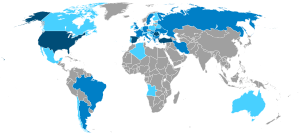
Back Romsko iseljeništvo Croatian Ромска дијаспора Macedonian Diaspora rome Albanian Ромска дијаспора Serbian Ромська діаспора Ukrainian
This article needs additional citations for verification. (October 2019) |


* The size of the wheel symbols reflects absolute population size
* The gradient reflects the percent in the country's population: 0% 10%.
The Romani diaspora refers to the presence and dispersion of Romani people across various parts of the world. Their migration out of the Indian subcontinent occurred in waves, with the first estimated to have taken place in the 6th century.[2][3] They are believed to have first arrived in Europe sometime between the 9th and 14th centuries, via the Balkans.[4][5][6] They settled in the areas of present-day Turkey, Greece, Serbia, Romania, Croatia, Moldova, Bulgaria, North Macedonia, Hungary, Albania, Kosovo, Montenegro, Bosnia and Herzegovina, Czech Republic, Slovenia and Slovakia, by order of volume, and Spain. From the Balkans, they migrated throughout Europe and, in the 19th and later centuries, to the Americas. The Roma population in the United States is estimated at more than one million.[7]
Romani people are predominantly found in Europe, particularly in the Balkans, parts of Central Europe and Spain. The total number of Romani people living outside Europe are primarily in the Middle East and North Africa and in the Americas, and are estimated in total at more than two million.[8][9] Most Romani populations overseas were founded in the 19th century by emigration from Europe. There were Romani people with Christopher Columbus on his third voyage to Hispaniola in 1498.[10] Some countries do not collect data by ethnicity. As of the early 2000s, an estimated 4 to 9 million Romani people lived in Europe and Asia Minor,[11] although some Romani organizations estimate numbers as high as 14 million.[12]
There is no official or reliable count of the Roma populations worldwide.[13] Many Roma refuse to register their ethnic identity in official censuses for fear of discrimination.[14] There are also some descendants of intermarriage with local populations who no longer identify exclusively as Romani, or who do not identify as Romani at all.
The Romani people identify with distinct sub-ethnic groups based in part on territorial, religious, cultural and dialectal differences, and self-designation. The main branches are:[15][16][17][18]


- Roma, concentrated in Central and Eastern Europe and Italy.
- Sinti, concentrated in Germany, Austria, Switzerland, France and Italy.
- Kalderash, concentrated in Romania, Bulgaria, Serbia and Hungary.
- Calé, concentrated in Spain, but also in Portugal (see Romani people in Portugal) and southern France.
- Manouche, concentrated in France and Belgium.
- Romanlar, in Turkey.
- Romanichal, in England, the Scottish Borders, northeast Wales and south Wales.
- Romanisael, in Sweden and Norway.
- Gurbeti, concentrated in Turkey, Albania, Bulgaria, Kosovo and Serbia
- Boyash, concentrated in Romania and Moldova.
- Ursari, concentrated in Romania and Moldova.
- Kaale, in Finland and Sweden.
- Kalé, in Wales.
- Lovari, concentrated in Hungary, Slovakia and the Czech Republic.
- Sevlengere in Greece and Turkey.
- Lowland Romani, in the Scottish Lowlands.
Since the 19th century, many Romani people have migrated from Europe to the Americas. They have also migrated to Australia, New Zealand and South Africa.
Romani people have additional internal distinctions, with groups identified as; Xoroxane (Muslim Roma in the Balkans); Xaladytka (Ruska Roma); Bashaldé; Churari; Ungaritza; Machvaya (Machavaya, Machwaya, or Macwaia) in Serbia; Romungro in Hungary and neighbouring Carpathian countries; Erlides (Yerlii, Arli); Argintari from silversmiths; Aurari from goldsmiths; Florari from florists; and Lăutari from singers.
- ^ "Council of Europe website". European Roma and Travellers Forum (ERTF). 2007. Archived from the original on 6 July 2007.
- ^ Mendizabal, Isabel (2012). "Reconstructing the Population History of European from Genome-wide Data". Current Biology. 22 (24): 2342–2349. Bibcode:2012CBio...22.2342M. doi:10.1016/j.cub.2012.10.039. hdl:10230/25348. PMID 23219723.
- ^ "Genomic Study Traces Roma to Northern India", The New York Times, 10 December 2012. Findings recently reported also in Current Biology.
- ^ Popov, Shakir M. (2023). Marushiakova, Elena; Popov, Vesselin; Kovacheva, Lilyana (eds.). "History of the Gypsies in Bulgaria and Europe: Roma". University of St. Andrews. pp. 8–10.
- ^ "Introduction to Roma Culture" (PDF). USAID. 2007. p. 6.
- ^ Kenrick, Donald (5 July 2007). Historical Dictionary of the Gypsies (Romanies) (2nd ed.). Scarecrow. p. xxxvii. ISBN 978-0-8108-6440-5.
- ^ Quote: "Today, estimates put the number of Roma in the U.S. at about one million."
- ^ Mission To Earth. p. 244.
- ^ Sunal, Cynthia S.; Mutua, Kagendo (1 July 2013). Research on the Influences of Educational Policy on Teaching and Learning. IAP. ISBN 9781623962524 – via Google Books.
- ^ The Lion and the Unicorn - Volumes 11-12. 1987. p. 48.
- ^ 3.8 million according to Pan and Pfeil, National Minorities in Europe (2004), ISBN 978-3-7003-1443-1, p. 27f.; 9.1 million in the high estimate of Liégois, Jean-Pierre (2007). Roms en Europe, Éditions du Conseil de l'Europe.
- ^ Roma Travellers Statistics at the Wayback Machine (archived 6 October 2009), Council of Europe, compilation of population estimates. Archived from the original, 6 October 2009.
- ^ "European effort spotlights plight of the Roma", USA Today, 1 February 2005
- ^ Chiriac, Marian (29 September 2004). "It Now Suits the EU to Help the Roma". Other-News.info. Archived from the original on 23 August 2011. Retrieved 27 June 2007.
- ^ Hancock, Ian, 2001, Ame sam e rromane džene / We are the Romani People, The Open Society Institute, New York, page 2
- ^ Matras, Yaron, Romani: A linguistic introduction, Cambridge University Press, 2002, p. 5
- ^ "Names of the Romani People". Desicritics.org. Archived from the original on 7 May 2008. Retrieved 30 January 2009.
- ^ N. Bessonov, N. Demeter "Ethnic groups of Gypsies" Archived 29 April 2007 at the Wayback Machine, Zigane website, Russia